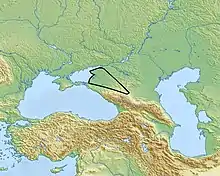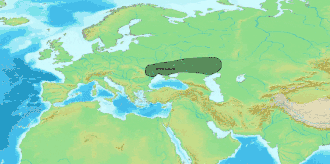Novotitarovskaya culture
Novotitarovskaya culture, also known as the Novotitorovka culture, was a Bronze Age archaeological culture which flourished in the North Caucasus ca. 3300–2700 BC.
 | |
| Geographical range | North Caucasus |
|---|---|
| Period | Early Bronze Age |
| Dates | ca. 3300–2700 BC |
| Preceded by | Yamnaya culture |
| Followed by | Catacomb culture |
| Bronze Age |
| ↑ Chalcolithic |
| Africa, Near East (c. 3300–1200 BC) |
|---|
|
Egypt, Anatolia, Caucasus, Elam, Levant, Mesopotamia, Sistan, Canaan Late Bronze Age collapse |
| Indian subcontinent (c. 3300–1200 BC) |
| Cemetery H |
| Europe (c. 3200–600 BC) |
|
Aegean (Cycladic, Minoan, Mycenaean), Caucasus, Catacomb culture, Srubnaya culture, Bell Beaker culture, Apennine culture, Terramare culture, Unetice culture, Tumulus culture, Urnfield culture, Proto-Villanovan culture, Hallstatt culture, Canegrate culture, Golasecca culture, Atlantic Bronze Age, Bronze Age Britain, Nordic Bronze Age |
| Eurasia and Siberia (c. 2700–700 BC) |
| Poltavka culture, Abashevo culture, Sintashta culture, Andronovo culture, Mezhovskaya culture, Cherkaskul culture |
| East Asia (c. 3100–300 BC) |
| Erlitou, Erligang, Gojoseon, Jomon, Majiayao, Mumun, Qijia, Siwa, Wucheng, Xindian, Yueshi, Xia dynasty, Shang dynasty, Sanxingdui, Zhou dynasty |
| ↓Iron Age |
| Part of a series on |
| Indo-European topics |
|---|
 |
The Novotitarovskaya culture was located immediately to the north of and largely overlapping portions of the Maykop culture facing the Sea of Azov,[1] running from the Kerch Strait eastwards, almost to the Caspian, roughly coterminous with the modern Krasnodar Krai region of Russia.[2]
It is distinguished by its burials, particularly by the presence of wagons in them and its own distinct pottery, as well as a richer collection of metal objects than those found in adjacent cultures, as is to be expected considering its relationship to the Maykop culture.[2]
It is grouped with the larger Yamnaya culture complex, often supposed as bearer of the Indo-European languages. In common with it, the economy was semi-nomadic pastoralism mixed with some agriculture.[2]
Notes
- Mallory & Adams 1997, p. 372.
- Mallory & Adams 1997, p. 396.
Sources
- Mallory, J. P.; Adams, Douglas Q. (1997). Encyclopedia of Indo-European Culture. Taylor & Francis. ISBN 9781884964985.
Further reading
| Wikimedia Commons has media related to Novotitorovka culture. |
- Mallory, J. P.; Adams, Douglas Q. (1997). "Novotitorovka Culture". Encyclopedia of Indo-European Culture. Taylor & Francis. p. 396. ISBN 9781884964985.